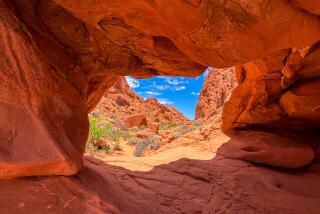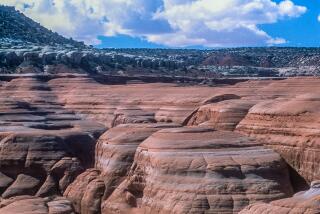Nevada Great Basin National Park, Newest in U.S., Opens
- Share via
BAKER, Nev. — The Great Basin National Park, America’s newest and possibly loneliest national park, shows that Nevada is more than casinos and nuclear test ranges, Gov. Dick Bryan said at dedication ceremonies Saturday.
“At last I believe we are fulfilling our initial promise to visitors--that Nevada is gaming and so much more,” Bryan said.
The 77,109-acre park, 300 miles north of Las Vegas, 250 miles southwest of Salt Lake City and 375 miles east of Reno, is a few miles off U.S. 50, known as “the loneliest road in America.”
The nearest town, five miles from park headquarters, is Baker, population 50, a rural hamlet that includes half a dozen houses, a bar, cafe, gasoline station, post office, two-room school, trailer park and seven-room motel.
Stunning Panorama
The first new national park in 15 years in the 48 contiguous states includes 13,063-foot Wheeler Peak and other stunning mountains towering above sagebrush-studded desert, alpine lakes, deep limestone caves, lush meadows and groves of gnarled bristlecone pine, the oldest living trees.
William Penn Mott Jr., director of the National Park Service, said the park “is not a whim of the moment. It has been under consideration for more than a half-century.”
The park was blocked repeatedly by Nevada mining and agricultural interests. Under a compromise plan signed last October by President Reagan, mining can continue on existing claims in the park and grazing of cattle and sheep on the flanks of Wheeler Peak can continue in perpetuity.
The park is considered representative of the often abrupt contrasts found in the Great Basin geological system, whose mountain ranges were once described by geographer C.E. Dutton as “an army of caterpillars crawling toward Mexico.”
Underground Caves
The park headquarters and visitor center is at Lehman Caves, nearly a mile of spectacular underground limestone caves discovered by a local farmer in 1885. The caves got national monument status in 1922.
More to Read
Sign up for The Wild
We’ll help you find the best places to hike, bike and run, as well as the perfect silent spots for meditation and yoga.
You may occasionally receive promotional content from the Los Angeles Times.






